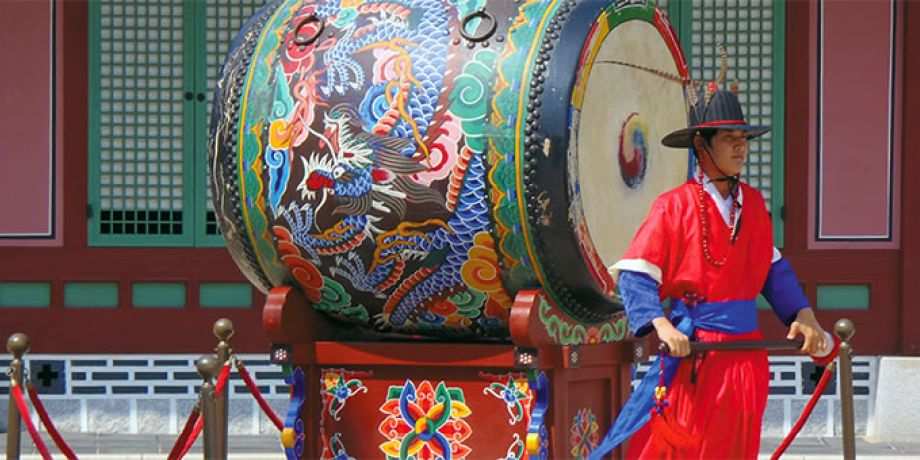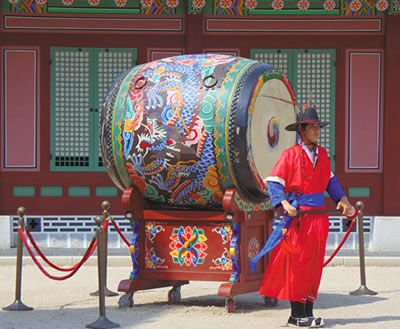
An Interview with Columban Fr. Denis Monaghan
When did you arrive in Korea?
I came here on October 2, 1969.
What were the Columbans doing there at the time you arrived?
It was almost 100% parish work. A small number were teaching in universities, but some people didn't see this as the work of a priest.
When you came to Korea how many Columbans were there, and how many parishes did they work in?
There were 152 Columbans in 71 parishes. There were 51 Columbans in the south, in Kwangju, and the rest were in Chuncheon and Wonju north of Seoul. There were just two priests in pastoral work in Seoul, in the parish of Donam near the present Columban Center House.
Was there any particular reason why they worked in the areas you mentioned?
Columbans came at the invitation of the Paris Foregin Missionaries (MEP) in 1933 and then, the following year the MEP passed on responsibility for all of the area of Chollanamdo in the south of the country and the island of Jeju.
You went to Korea as a newlyordained priest. There is a piece of ancient advice "When in Rome do as the Romas do." Can you remember how the "new Rome" might have made you change?
The older men who were here – we saw them as grandfathers who were very welcoming and kind to us. They thought we were geniuses because we were doing systematic study of Korean language whereas they had not had the opportunity to learn much. The younger ones were tougher on us. One reason was that we came from what was known as "the class of '69." That was a time of many tensions within the Church; the years immediately after the Second Vatican Council. There had been, shall we say, some differences of opinion in the seminary and ordinations for our class had been delayed because some superiors deemed that we weren't yet mature enough. The result was the suspicion that we were potential troublemakers who needed a bit of watching.
 Had the changes made by the Vatican Council reached Korea by then?
Had the changes made by the Vatican Council reached Korea by then?
Change was taking place, but I remember that when my group of six arrived in Kwangju we had to present ourselves to the archbishop and take the Oath Against Modernism This oath, coming from the time of Pope Pius X in 1910 rejected a lot of the things that Vatican II accepted. Archbishop Harold Henry was by no means a reactionary but presumably he felt bound by some rule of other that hadn't yet been removed from the books. As the text was in Latin, we weren't too clear about what we were promising.
In 2018 the Columbans mark 100 years of existence and over 80 years in Korea. What has been the contribution here?
The big objective in coming here was to help establish the local church and then move on. Columbans founded 130 new parishes in Korea. Many of those have been subdivided, and it is possible that the total number now is in the region of 300. We handed each parish over to the local diocese when it became self-supporting, so the Korean Church had a positive impression of our work. We were not here to build our own kingdom. Originally Columbans worked with Columban bishops. There's no longer Columban bishops here, but relationships between Columbans and local bishops have been good.
Did some priests feel a loss of identity as parishes were handed over to Korean priests and opportunities for this kind of pastoral work decreased?
Some did, and they went elsewhere. But others became involved in a different kind of work. For example, the Korean Church has now become a missionary church with about 1,000 missionaries overseas, and the Columbans have played an important role in this movement. We now send young Korean Columban priests to other countries, and we accept Korean diocesan priests as associates for mission abroad for three to six year periods. We run preparation courses for Korean missionaries going abroad. I think we can help them avoid making some of the mistakes that we made at the beginning. In some instances there are now agreements and exchange between Korean diocese and other dioceses overseas.
How about lay missionaries?
We have had 61 Korean lay missionaries in seven countries. One is now a Columban seminarian. We thought there would be a big number of lay missionary volunteers, given the life of the Korean Church, but the number has remained relatively small. At the beginning it took us a while to get used to them; and them to us. They do good work abroad. Their occasional presence in this Columban center house has helped us to improve our language, our Korean language I mean.
Materially, there is a big difference between now and 50 years ago. The situation today is different.
Several years ago Cardinal Kim of Seoul warned of the danger of the Korean Church getting too rich. Local churches can easily become places where the poor don't feel welcome. Korean Catholics are extremely generous. Many are former Buddhists, and they had the custom of giving generous offerings to monasteries. Fifty years ago we had very little ourselves. The monthly allowance was about $59, and a lot of that went as a contribution to the parish priest for house upkeep, food, etc.
What are the things you admire about the Korean Church?
I admire the way the priests work hard. I'd say, of course, that the people won't let you be lazy; there always seems to be something else to be done–and soon.
You mentioned that Columbans are now doing other work. Can you give some examples?
There are plenty of things to be done; sometimes they are things that other people are less keen to do; hearing confessions for example. For myself, I handled money matters here for eight years in the Columban headquarters; now I'm the house manager. But I also have pastoral commitments outside such as English Masses in the Cathedral, confessor for Sisters and for Seoul Diocesan priests; morning Masses four days a week in a 100-strong community of Benedictine Sisters and Masses for other religious communities. I also see myself as a "referral man." I help to steer people to where they can get help. Columban Frs. Gery Cotter and Liam McCarron got training in this area many years ago and were influential in getting counseling services founded in Korea. There are many other activities – a retreat center, large agricultural project, work with special needs children and adults, and more.
In your spare time you have put in multiple hours researching Columban history, photographs, letters, and more. Could you say a little about what thoughts come to mind having gone through so much material?
In 1994, the then director Fr. Michael O'Grady asked me to be the region archivist. When I went looking for what I was supposed to archive, I found that there were almost no files, photos, letters, etc. We were not good at keeping records or memorabilia, so I began to move in quickly any time one of our group died to make sure that I got copies at least of any relevant material before it was thrown out by some efficient cleaner! In the past we didn't have much concern for our history; it was the Seoul Archdiocese that pushed me to do some historical research. After seven years I was able to publish a book of historical photos. Almost immediately the comments came, "Why wasn't XYZ included?" My answer was, "For seven years I have been asking people to send me photos and I got very little response." Next question "Do you plan to publish another one?" I have now published seven volumes with 500 pages each. We are now in the process of digitizing and enhancing the photos. I think one of the difficulties was that people, out of a fear of appearing proud, were slow to write or talk about their achievements, if you like to call it that. Sometimes, too, the need to keep up a rugged appearance, even in the midst of loneliness or other difficulties, made people less willing to talk about life and work.
You came out of the Irish Church and have spent your life in the Korean Church. What are the differences and similarities?
I remember Fr. Kevin Mangan, an Australian Columban saying "When you come here you go through three phases. The first one is where everything is wonderful–the best ever. Then, something happens, some setback, and the place becomes intolerable. Finally you reach a third phase where you say that it's really an OK place after all." I admire the ability of the Koreans to start off again when things collapse.
One interesting difference that struck me was that while we tend to turn to the Lord when we are in trouble, some people I know here in Korea seem to think that one shouldn't bother the Lord in times of trouble. Wait until things are sorted out a bit seems to be the approach. I continue to learn even after 50 years. It is hard to change habits–for example, the Christmas crib collection box. I remember one Christmas I said that we shouldn't have a collection box. When I looked at the crib the day after Christmas, the floor was covered in money.
When you left St. Mel's College in Longford in 1962 joining the Columbans looked like a good idea at that time. Is it still a good idea?
Maybe it looks even better now. The year I left St. Mel's, thirteen of the twenty-five boarders of my class went to seminaries. Of those, five are priests, one a bishop. Those kind of numbers changed dramatically within ten years. But I have never regretted the decision and I have found it a fulfilling life even if I had to change some of my ideas and illusions with the passing of time.
Columban Fr. Denis Monaghan lives and works in South Korea.